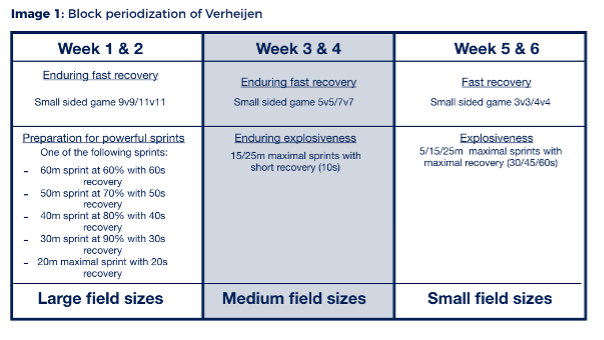Good performance in team sports requires different abilities: stamina, explosive accelerations, sprinting and the ability to change direction quickly. As a trainer/coach it is your job to train these factors. There are several training models available that can help you get your players fit. In the previous blogs we will also discuss the different models, including the activity physiologist Raymond Verheijen and movement scientist Tim Gabbett. In the third and last blog of this series we discuss how JOHAN Sports shares the vision of both models!
Aerobic, anaerobic and phosphate systems
In many books on exercise physiology, difficult terms such as aerobic, anaerobic and phosphorus systems are used to describe physical capacities of athletes. For example, the aerobic system (endurance) is very important for cyclists and the phosphate system (explosiveness) is very important for sprinters in athletics. The challenge in team sports such as football and hockey, however, is that all three systems have to be trained in their own way and are therefore important for the performance of players. It is therefore your task as a coach to train the aerobic, anaerobic and phosphate systems of your players. But how do you train these systems? And what role do these systems play in performance?
Football condition
Raymond Verheijen is one of the first exercise physiologists who has been able to translate these difficult, abstract terms into soccer-specific terms. This is how he described the ‘football condition’ in the following 4 capacities: explosiveness (being able to act quickly/explosively in a small space), perseverance of explosiveness (being able to act explosively, even at the end of the match), recovering quickly (being able to recover quickly after an intensive sprint, so that many sprints can be made in a short time), insist on recovering quickly (being able to make many sprints, even at the end of the race). By linking these four terms to football-specific exercise forms, Verheijen has succeeded in providing trainers with tools for their training schedule.
Block periodisation by Raymond Verheijen
What is also a strong point of Verheijen’s model is that he uses block periodization: each period the focus is on one or two of the physical capacities of the football condition1,2. It is known that endurance training (persistence of fast recovery) reduces the training effects of strength training (explosiveness)1,2. It is therefore important to focus on a minimum number of aspects at the same time in order to achieve the maximum training effect. In addition, simultaneous training of different aspects could also lead to an overload of the athlete1,2. As a result, Verheijen’s ‘block periodization’ also ensures that players do not get overtrained.
6 week CYCLUS of RAYMOND VERHEIJEN
Verheijen’s block periodization model consists of a cycle of 6 weeks, with the focus shifting to a different capacity every two weeks (see Figure 1). One of the appealing aspects of this model is that it scales down in each cycle from large field sizes in the first and second week (high volume, low intensity) to small field sizes in the fifth and sixth week (low volume, high intensity). He has also developed several steps in his model, whereby a step up in the model is made with each cycle (this often means that the duration of an exercise becomes longer, a higher number of repetitions, or the rest periods shorter). This means that a trainer can easily determine the entry level of his/her team, and then slowly climb up the step-by-step plan to get the players fitter and fitter.

Disadvantages of block periodisation
Following this step-by-step schedule has resulted in several teams becoming fitter during the season. The disadvantage is that following this step-by-step plan does not make it clear whether your players are at their maximum level, or whether they can handle more load than the step-by-step plan prescribes. Are you increasing the load while your players are at their maximum level or are you progressing too many steps in one cycle? An overload can result in injuries. Verheijen’s periodization model does not provide insight into how much load a player (or the team) can handle. This makes it difficult to determine the right load (and therefore the optimal training schedule) for your team.
Tim Gabbett’s model, on the other hand, focuses on determining the amount of load that a player (or the team) can handle3. In the next blog, we will discuss this theory, so that you as a coach can make Verheijen’s model even more specific!
Conclusion
Raymond Verheijen was one of the first to succeed in making difficult physiological processes understandable for all trainers/coaches and linking them to football-specific forms of exercise. By applying block periodization, he ensures maximum effect from the training sessions. However, it is difficult to determine the exact amount of load for your team. To gain insight into how much load your team can handle, we will discuss Tim Gabbett’s theory in the next blog.
